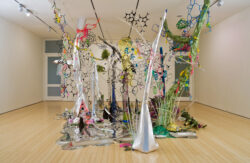Sally Heller
Multimedia installation artist Sally Heller uses ordinary household items, construction materials, and other found objects to create room-size installations.

Courtesy of Sally Heller
Up Rooted. Heller, Sally (Artist)
Sally Heller’s multimedia installations entertain, but more important they make one think about the absurdities of modern society and pop culture and the delicate balance between mass consumerism and a vulnerable environment. Heller, born in New Orleans on January 3, 1956, uses improbable, yet ordinary, household and construction materials and the detritus of modern society to create an illusionary sense of natural beauty. Heller’s room-size installations are often statements about the struggle to preserve the environment amid a culture of exploitation. She assembles petrochemical and other non-biodegradable objects to create an organic-looking world. Her materials are often purchased at dollar stores, major hardware stores, or garage sales. Heller uses these utilitarian objects as a painter would a palette. Commercial objects in their various colors are her paints; clippers, pliers, and scissors are her brushes. Heller works to make something beautiful out of something trite. “The cheaper it is,” she said, “the more I’m interested in it. … Taking these goods and using them as organic parts of a landscape is an interesting flip-flop. There’s nothing organic in anything I use. I’m putting these materials together that are taken for granted.” She adds: “I’ve always had an irreverent side.”
Heller received a BS from the University of Wisconsin in Madison, and MFA from Virginia Commonwealth University in Richmond. She lived and worked in Brooklyn, New York, from 1980 to 1995. Like all art students, Heller studied painting, but she preferred the openness and freedom of installation work that knows no boundaries or prescribed materials. Of her installations, she said, “It’s like making a giant painting, but only in three dimensions. My installations look very two dimensional but they are not, and that’s probably because of my training as a painter.” In creating her own artistic voice, Heller says she was most influenced by Cornelia Parker for her methods of suspending objects, Lucas Samaras for his wide range use of cultural materials, and by Judy Pfaff for her choreography of three-dimensional space.
For years, Heller used ordinary materials to make amorphous forms and shapes with no recognizable imagery. Then in 2004, while participating in a show for the Contemporary Arts Center in New Orleans, she purchased a large box filled with yellow bottle caps. “I was fooling around with them and as I attached other bottle caps to them, it became a tree,” she said. “I then began to notice trees around me. I drove down Carrollton Avenue in New Orleans and saw these young trees braced with wires to help them grow straight. They looked crippled to me. It was poignant. Here’s man trying to regulate the growth of a tree. They took on a demeanor of a sad person not allowed to grow like they wanted to grow. I started using that as a means to express my art.”
From there, she realized how trees, especially in a swamp setting, could conceptually fill space on a gallery floor. “I began to think differently. My work then became one giant installation rather than individual pieces. I set the stage by covering the floor with reflecting Mylar, which is like water reflecting all these colors from above. Creating swamps solved space issues for me. And the swamps are my natural environment.”
More than simply filling space efficiently, Heller found a way to create a conversation with her viewers through these fantasy swamps. Constructing unrecognizable objects with ordinary, everyday materials made its point, but creating a landscape, like a swamp, inspired discussion at more intense levels. “They are metaphors for the world we live in and the constant mass production of commercial goods,” she claimed. “These trees show new growth and the ever present clutter we consume. The idea of using nature as a format is opportunistic because I can take it anywhere I want to go with it. The options are endless. Nature itself is endless and infinite.”
Heller’s art works have been exhibited in galleries from New Orleans to New York and California. Major fellowships and grants include a Joan Mitchell Grant for Art in public spaces; a Yaddo Artist Residency; a One Percent for the Arts project in New Orleans; a Joan Mitchell Emergency grant; and a residency at the Headlands Center for the Arts in Sausalito, California. In addition to several private collections, her installations can be found at the New Orleans Museum of Art and the Sydney and Walda Besthoff Collection, Freeport McMoRan, and the New Iberia Bank in New Orleans.
